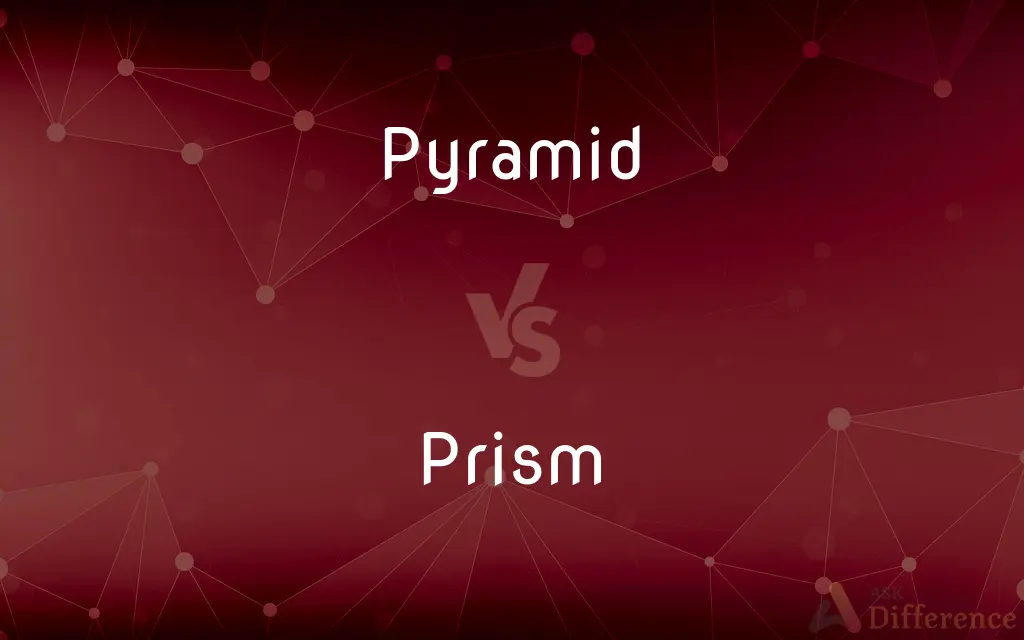Pyramid vs. Prism — What's the Difference?
Edited by Tayyaba Rehman — By Fiza Rafique — Updated on October 10, 2023
A pyramid is a polyhedron with a base and triangular faces converging to a single point, while a prism is a polyhedron with two parallel and congruent polygonal bases and rectangular or parallelogram sides.

Difference Between Pyramid and Prism
Table of Contents
ADVERTISEMENT
Key Differences
The terms "pyramid" and "prism" both refer to three-dimensional geometric shapes, but they have distinct characteristics. A pyramid is defined as a solid shape with a polygonal base and triangular sides that meet at a single apex or vertex. The pyramid's base can be any polygon, but its faces are always triangles that converge to a singular point. The most commonly recognized pyramid is the square pyramid, which has a square base and four triangular sides. The ancient Egyptians, for instance, constructed monumental square pyramids as tombs for their pharaohs.
Contrastingly, a prism is a solid figure that has two parallel and congruent polygonal bases. The sides of a prism, which connect the corresponding vertices of the two bases, are always parallelograms, often rectangles. The height of a prism is the perpendicular distance between its two bases. One of the most familiar prisms is a rectangular prism or box, which has rectangular sides and a rectangular base. However, prisms can have bases of any shape, be it triangular, hexagonal, or any other polygon.
The primary distinction between pyramids and prisms lies in their structures and the nature of their faces. While pyramids taper to a single point, prisms maintain a uniform cross-section along their height. Furthermore, pyramids are characterized by their triangular faces, while prisms are recognized by their parallelogram or rectangular sides and two congruent bases.
To recap, both pyramids and prisms are polyhedra with flat faces, straight edges, and sharp corners or vertices. Yet, their structural designs are notably different, with pyramids converging to a point and prisms maintaining parallel bases throughout their length.
Comparison Chart
Definition
Polyhedron with a base and triangular faces
Polyhedron with two parallel and congruent bases
ADVERTISEMENT
Faces
Triangular (except for the base)
Rectangular or parallelogram, depending on the bases
Vertex
Single apex or vertex
No apex; vertices defined by the polygonal bases
Base
Can be any polygon
Two congruent and parallel polygons
Examples
Egyptian pyramids, tetrahedron
Rectangular box, triangular prism
Compare with Definitions
Pyramid
Pyramid's sides are always triangular.
The four-sided pyramid in Egypt has a square base and four triangular faces.
Prism
Prism has two parallel polygonal bases.
A triangular prism has two congruent triangular bases.
Pyramid
A pyramid (from Greek: πυραμίς pyramís) is a structure whose outer surfaces are triangular and converge to a single step at the top, making the shape roughly a pyramid in the geometric sense. The base of a pyramid can be trilateral, quadrilateral, or of any polygon shape.
Prism
Prism can have bases of any polygonal shape.
The glass prism used in physics labs is usually a triangular prism.
Pyramid
A monumental structure with a square or triangular base and sloping sides that meet in a point at the top, especially one built of stone as a royal tomb in ancient Egypt.
Prism
Prism's cross-section remains uniform along its height.
If you cut a prism horizontally, each section would resemble its base.
Pyramid
An object, shape, or arrangement in the form of a pyramid
A pyramid of logs
A pyramid roof
Prism
An optical prism is a transparent optical element with flat, polished surfaces that refract light. At least one surface must be angled — elements with two parallel surfaces are not prisms.
Pyramid
A system of financial growth achieved by a small initial investment, with subsequent investments being funded by using unrealized profits as collateral
The eventual collapse of illegal pyramids
Prism
A solid figure whose bases or ends have the same size and shape and are parallel to one another, and each of whose sides is a parallelogram.
Pyramid
Stack or arrange in the shape of a pyramid.
Prism
A transparent body of this form, often of glass and usually with triangular ends, used for separating white light passed through it into a spectrum or for reflecting beams of light.
Pyramid
Achieve a substantial return on (money or property) after making a small initial investment
A bank can pyramid modest capital into an enormous sum of money
Prism
A cut-glass object, such as a pendant of a chandelier.
Pyramid
A solid figure with a polygonal base and triangular faces that meet at a common point.
Prism
A crystal form consisting of three or more similar faces parallel to a single axis.
Pyramid
Something shaped like this polyhedron.
Prism
A medium that misrepresents whatever is seen through it.
Pyramid
A massive monument of ancient Egypt having a rectangular base and four triangular faces culminating in a single apex, built over or around a crypt or tomb.
Prism
(geometry) A polyhedron with parallel ends of the same size and shape, the other faces being parallelogram-shaped sides.
Pyramid
Any of various similar constructions, especially a four-sided Mesoamerican temple having stepped sides and a flat top surmounted by chambers.
Prism
A transparent block in the shape of a prism (typically with triangular ends), used to split or reflect light.
Pyramid
The transactions involved in pyramiding stock.
Prism
A crystal in which the faces are parallel to the vertical axis.
Pyramid
(Anatomy) A structure or part suggestive of a pyramid in shape.
Prism
A solid whose bases or ends are any similar, equal, and parallel plane figures, and whose sides are parallelograms.
Pyramid
To place or build in the shape of a pyramid.
Prism
A transparent body, with usually three rectangular plane faces or sides, and two equal and parallel triangular ends or bases; - used in experiments on refraction, dispersion, etc.
Pyramid
To build (an argument or thesis, for example) progressively from a basic general premise.
Prism
A polyhedron with two congruent and parallel faces (the bases) and whose lateral faces are parallelograms
Pyramid
To speculate in (stock) by making a series of buying and selling transactions in which paper profits are used as margin for buying more stock.
Prism
Optical device having a triangular shape and made of glass or quartz; used to deviate a beam or invert an image
Pyramid
To assume the shape of a pyramid.
Prism
Prism is a three-dimensional shape with two congruent bases and parallelogram sides.
A cereal box is an example of a rectangular prism.
Pyramid
To increase rapidly and on a widening base.
Prism
Prism's sides connect the corresponding vertices of its bases.
The height of a prism is the distance between its two parallel bases.
Pyramid
To pyramid stocks.
Pyramid
An ancient massive construction with a square or rectangular base and four triangular sides meeting in an apex, such as those built as tombs in Egypt or as bases for temples in Mesoamerica.
Pyramid
A construction in the shape of a pyramid, usually with a square or rectangular base.
Pyramid
(geometry) A solid with triangular lateral faces and a polygonal (often square or rectangular) base.
Pyramid
(neuroanatomy) A medullary pyramid, the medial-most bumps on the ventral side of the medulla oblongata
Pyramid
The game of pool in which the balls are placed in the form of a triangle at spot.
Pyramid
A pyramid scheme.
Pyramid
Alternative case form of Pyramid}}. {{gloss
Pyramid
(card games) The triangular layout of cards in the game of Pyramid.
Build your pyramid with all cards face down, except the cards in the bottom row.
Pyramid
(journalism) An approximately triangular headline consisting of several centered lines of text of increasing length.
Pyramid
To build up or be arranged in the form of a pyramid.
Pyramid
To combine (a series of genes) into a single genotype.
Pyramid
(intransitive) To employ, or take part in, a pyramid scheme.
Pyramid
(finance) To engage in pyramid trading.
Pyramid
A solid body standing on a triangular, square, or polygonal base, and terminating in a point at the top; especially, a structure or edifice of this shape.
Pyramid
A solid figure contained by a plane rectilineal figure as base and several triangles which have a common vertex and whose bases are sides of the base.
Pyramid
The game of pool in which the balls are placed in the form of a triangle at spot.
Pyramid
A fraudulent investment scheme in which the manager promises high profits, but instead of investing the money in a genuine profit-making activity, uses the money from later investors to pay the profits to earlier investors; - also called pyramid scheme or pyramid operation. This process inevitably collapses when insufficient new investors are available, leaving the later investors with total or near-total losses of their investments. The managers usually blame government regulations or interference for the collapse of the scheme, rather than admit fraud.
Pyramid
To enlarge one's holding or interest in a series of operations on a continued rise or decline by using the profits to buy or sell additional amounts on a margin, as where one buys on a 10% margin 100 shares of stock quoted at 100, holds it till it rises to 105, and then uses the paper profit to buy 50 shares more, etc. The series of operations constitutes a pyramid. A similar process of reinvesting gains or winnings (as of a gamble), but not involving operation on margin, is called a parlay.
Pyramid
A polyhedron having a polygonal base and triangular sides with a common vertex
Pyramid
(stock market) a series of transactions in which the speculator increases his holdings by using the rising market value of those holdings as margin for further purchases
Pyramid
A massive memorial with a square base and four triangular sides; built as royal tombs in ancient Egypt
Pyramid
Enlarge one's holdings on an exchange on a continued rise by using paper profits as margin to buy additional amounts
Pyramid
Use or deal in (as of stock or commercial transaction) in a pyramid deal
Pyramid
Arrange or build up as if on the base of a pyramid
Pyramid
Increase rapidly and progressively step by step on a broad base
Pyramid
Pyramid is a geometric solid with a polygon base and triangular faces.
The Egyptian pyramids are famous historical structures.
Pyramid
Pyramid's faces converge to a singular apex.
The point at the top of the pyramid is its apex.
Pyramid
Pyramid can have any polygonal shape as its base.
A tetrahedron is a pyramid with a triangular base.
Pyramid
Pyramid is often associated with ancient monumental structures.
The Great Pyramid of Giza is one of the Seven Wonders of the Ancient World.
Common Curiosities
What's the difference between a rectangular prism and a cube?
Both are prisms, but a cube has all sides equal in length, making it a special case of a rectangular prism.
Are pyramids always tall and pointed?
No, the height and slope of a pyramid's sides can vary, but they always converge to a single point.
Do pyramids have a uniform cross-section like prisms?
No, pyramids taper to a point, so their cross-section changes along their height.
Are all the sides of a pyramid triangles?
Yes, all sides (faces) of a pyramid are triangles, except for the base, which can be any polygon.
Can a prism have a circular base?
No, a solid with circular bases is called a cylinder, not a prism.
How many faces does a square pyramid have?
A square pyramid has 5 faces: 4 triangles and 1 square.
How many edges does a triangular prism have?
A triangular prism has 9 edges.
Can the base of a pyramid be a circle?
No, a solid with a circular base and a pointed top is called a cone.
Can a prism's bases be triangles?
Yes, in that case, it's called a triangular prism.
How many vertices does a cube (a type of prism) have?
A cube has 8 vertices.
Are all prisms long and elongated?
No, the height of a prism can vary. A cube is a type of prism and isn't elongated.
Is a cone a type of pyramid?
No, a cone is a different geometric solid with a circular base and a curved surface that tapers to a point.
Can the sides of a prism be triangles?
No, the sides of a prism are parallelograms (often rectangles). Only the bases can be triangles.
Which shape, pyramid or prism, is used more in architecture?
Both shapes are used, but prisms, especially rectangular ones, are more common in modern buildings.
Which has more faces: a triangular pyramid or a triangular prism?
A triangular prism has 5 faces, while a triangular pyramid has 4.
Share Your Discovery

Previous Comparison
Wage vs. Income
Next Comparison
Comedic vs. ComicAuthor Spotlight
Written by
Fiza RafiqueFiza Rafique is a skilled content writer at AskDifference.com, where she meticulously refines and enhances written pieces. Drawing from her vast editorial expertise, Fiza ensures clarity, accuracy, and precision in every article. Passionate about language, she continually seeks to elevate the quality of content for readers worldwide.
Edited by
Tayyaba RehmanTayyaba Rehman is a distinguished writer, currently serving as a primary contributor to askdifference.com. As a researcher in semantics and etymology, Tayyaba's passion for the complexity of languages and their distinctions has found a perfect home on the platform. Tayyaba delves into the intricacies of language, distinguishing between commonly confused words and phrases, thereby providing clarity for readers worldwide.
















































